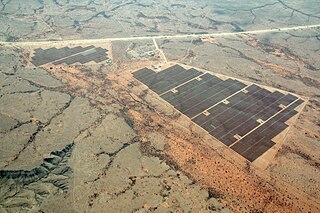
Tsumeb is a city of 15,000 inhabitants and the largest town in the Oshikoto region in northern Namibia. Tsumeb is known as the "gateway to the north" of Namibia. It is the closest town to the Etosha National Park. Tsumeb used to be the regional capital of Oshikoto until 2008 when Omuthiya was proclaimed a town and the new capital. The area around Tsumeb forms its own electoral constituency and has a population of 44,113. The town is the site of a deep mine that in its heyday was known as "TCL", but has since been renamed the Ongopolo Mine.

Concor Holdings (Proprietary) Limited. is a South African construction and mining services company. It is active throughout Southern Africa, involved in civil engineering, buildings, roads and mining projects. Concor returned as an independent brand in late 2016.

Namibia Power Corporation, commonly known as NamPower, is the national electric power utility company of Namibia. The company is responsible for generation, transmission and distribution of electricity in the country. Its activities are licensed, supervised and regulated by the Electricity Control Board (ECB) of Namibia.

Namibia is an arid country that is regularly afflicted by droughts. Large rivers flow only along its northern and southern borders, but they are far from the population centers. They are also far from the country's mines, which are large water users. In order to confront this challenge, the country has built dams to capture the flow from ephemeral rivers, constructed pipelines to transport water over large distances, pioneered potable water reuse in its capital Windhoek located in the central part of Namibia, and built Sub-Saharan Africa's first large seawater desalination plant to supply a uranium mine and the city of Swakopmund with water. A large scheme to bring water from the Okavango River in the North to Windhoek, the Eastern National Water Carrier, was only partially completed during the 1980s.

B2Gold Corporation is a Canadian mining company that owns and operates gold mines in Mali, Namibia and the Philippines. The company is headquartered in Vancouver, and was founded in 2007, and was then listed on the Toronto Stock Exchange, then later listed on the New York Stock Exchange and the Namibian Stock Exchange. The company was formed by several executives from Bema Gold following its acquisition by Kinross Gold. The company built itself up through mergers with several other mining companies, including Central Sun Mining, CGA Mining, Auryx Gold and Papillon Resources to give it five operating mines, two of which have been divested, and several exploration properties.
The Erongo Desalination Plant, also known as the Orano Desalination Plant, is a sea water desalination plant in Namibia. The facility was constructed between 2008 and 2010 by Orano Mining Namibia, which at the time was known as Areva Resources Namibia. The desalination plant was established to supply water to Orano’s Trekkopje Uranium Mine. At the time this plant was commissioned, it was the largest reverse osmosis desalination plant in Southern Africa.

The Mariental Solar Power Station is a 45.5 MW (61,000 hp) solar power plant in Namibia. The project is owned and was developed by a consortium of various IPPs and the Namibian electricity utility company, NamPower.
The Exxaro Solar Power Station, also Lephalale Solar Power Station, is a planned 80 MW (110,000 hp) solar power plant in South Africa. The solar farm is under development by Cennergi, a subsidiary of Exxaro Resources Limited, a South African multinational mining group, active in Africa, Asia, Australia and Europe. The energy generated here will be sold to Exxaro Coal Plc, for use in their coal mine at Grootegeluk, under a long-term power purchase agreement (PPA), between the two Exxaro subsidiaries. The expected benefits to the group include (a) reduction of the group's carbon footprint (b) financial savings on energy acquisition and utilization and (c) to provide green, secure and sustainable electricity for mine operations at Grootegeluk Coal Mine.
The Mogalakwena Solar Power Station is a planned 100 MW (130,000 hp) solar power plant in South Africa. The solar farm is under development by a consortium comprising Pele Green Energy, a South African independent power producer (IPP) and EDF Renewables, a subsidiary of the French energy multinational Électricité de France (EDF). The energy generated here will be used to supply the Mogalakwena platinum mine of Anglo American Platinum, in Limpopo Province.
The Khan Solar Power Station, is a 20 megawatts (27,000 hp) solar power plant under construction in Namibia. The project is owned and under development by Access Aussenkehr Solar One Namibia a Namibian independent power producer (IPP), based in Windhoek, the country's capital city. The energy generated here will be purchased by NamPower, the national electricity utility company, which is wholly owned by the government of Namibia. A 25-year power purchase agreement (PPA), governs the terms under which the energy will be sold and bought.
The Balama Solar Power Station, is a 11.25 megawatts (15,090 hp) solar power plant under construction in Mozambique. The project is owned and under development by Solarcentury an independent power producer (IPP), based in the United Kingdom. The solar farm will be connected to an 8.5 MW/8.5MWh battery storage system. The two energy sources will then be synchronized with the existing 15.4 MW diesel-fired thermal power source, to form a 35.15 MW hybrid power station. The energy generated here is used in the Balama Graphite Mine, owned and operated by Syrah Resources, a Canadian minerals and technology company.
The TeraSun Energy Solar Power Station is a planned 81 megawatts solar power plant in Namibia. The power station is owned and is being developed by a consortium comprising Natura Energy, a Namibia-based energy company and Globleq Africa Limited, an independent power producer (IPP), headquartered in the United Kingdom.
The Fekola Hybrid Power Station is a 115 MW (154,000 hp) power plant in Mali. The power system comprises 68 MW of thermal energy, 30 MW of solar power and 17.3 MW of lithium ion battery energy storage. The power station is owned by B2Gold Corporation, a Canadian mining company. Dornier Suntrace GmbH and BayWa, two German engineering consulting and construction companies were hired to advise, design, build, operate and maintain this power station. The off-taker is the Fekola Gold Mine, in southwestern Mali, that is off-grid and is owned by B2Gold.
The Diaz Wind Power Station, is a 44 MW (59,000 hp) power plant under construction in Namibia. The power station is under development and is owned by Diaz Wind Power, a joint venture company owned by (a) United Africa Group and (b) Quantum Power. The energy generated at this wind farm will be sold to NamPower, the national electricity parastatal company of Namibia, under a 25-year power purchase agreement (PPA).
The Kokerboom Power Station, is an 18.5 megawatts solar power plant under development in Namibia. The public private partnership (PPP) development project is owned by Alpha Namibia Industries Renewable Power (ANIREP), a Namibian independent power producer (IPP), who was awarded the concession in June 2022, to design, construct, finance, own, operate and maintain the power station. The energy off-taker is "Dundee Precious Metal", a Canadian mining company, for use in its mining operations in the area. This is possible via the national grid "through a modified single-buyer model", under Namibian laws.
The Omburu Solar Power Station, is a 20 megawatts solar power station in Namibia. The power station, which was developed and is owned by Namibia Power Corporation (Proprietary) Limited (NamPower), was constructed between March 2021 and June 2022 and was commercially commissioned on 24 June 2022. NamPower integrates the energy generated here, calculated at 67.8 GWh annually, into the Namibian grid. This is the first grid-connected PV solar power station, fully owned and operated by NamPower.
The Rosh Pinah Wind Power Station, is a planned 40 MW wind-power plant in Namibia. The wind farm is under development by Namibia Power Corporation Limited (NamPower), the Namibian electricity parastatal company. This wind farm is intended to increase Namibia's energy generation mix. An environmental impact assessment study by the consulting firm Enviro Dynamics, has been ongoing since 2020 and will inform the management of this renewable energy project.
The Bolobedu Solar Power Station is an 148 MW solar power plant planned in South Africa. The solar farm is owned and under development by a consortium led by Voltalia, the French multinational independent power producer (IPP) and Black South African shareholders, including a community trust. The off-taker of the power generated here is Richards Bay Minerals (RBM), a South African mining company owned by the Anglo-Australian mining conglomerate, Rio Tinto. The power will be conveyed from the solar farm to the customer's mine using the transmission lines of Eskom, the national electricity parastatal company, as is permissible under South African law.
The Cerim Luderitz Wind Power Station, is a 50 MW (67,000 hp) power plant that is being developed in Namibia. The power station is under development and is owned by Cerim Luderitz Energy, a joint venture company owned by (a) China Energy Engineering Corporation (CEEC) and (b) Riminii Investments, a Namibian company. The energy generated at this wind farm will be sold to NamPower, the national electricity parastatal company of Namibia, under a 25-year power purchase agreement (PPA).






